| 8 July 2022
As we head into the cold and wet months, registrations are now open for the first five webinars of the 2022 AWRI webinar program. Starting on Thursday, 21 July, Simone George, a Global Wine & Grape Broker from Ciatti, will lead you through the global bulk wine landscape, looking at key international markets and pending issues, including the supply and demand outlook for Australian grapes and wine. Other webinar topics in this winter block include the national vintage report for 2022, a biosecurity webinar on grapevine viruses and phytoplasmas, a comprehensive update on Sustainable Winegrowing Australia and a look at hail recovery and what has been learnt from the damage that occurred in the 2021 growing season. Each webinar includes a presentation and, where appropriate, a practitioner to contribute real-life examples and experiences. There will also be an opportunity for audience members to ask questions. Sessions are held on Thursdays at 11:30 am (SA time). All webinars are free to attend but do require pre-registration. The five upcoming webinars are: 21 July 2022: Global wine market trends – Simone George (Ciatti) 28 July 2022: Overview of the 2022 National Vintage Report – Sandy Hathaway (Wine Australia) 4 August 2022: Grapevine viruses and phytoplasmas: a biosecurity challenge for viticulture – Fiona Constable (Department of Jobs, Precincts and Regions – Agriculture Victoria) 11 August 2022: Sustainable Winegrowing Australia – Dr Mardi Longbottom (AWRI), Anna Hooper (Australian Grape & Wine), Dréa Hall (Wine Australia) 18 August 2022: Recovering from hail damage – looking back on what we learnt from the 2021 season – Chris Rogers (Rogers Viticulture) System requirements You will need a computer or mobile device with an internet connection. Audio is connected over the internet using your computer or mobile device’s speakers (voice over internet protocol – VOIP). Participants joining a webinar via a mobile device will need to download a free app available from iTunes or Google Play. If you’ve missed a previous AWRI webinar, you can watch online via the AWRI’s YouTube channel. For further information on AWRI webinars, please contact the AWRI events team. |
The Australian Wine Research Institute Blog
Launching Affinity Labs – a new identity for our commercial activities
27 June 2022 >27 June 2022
Today is an exciting day for the AWRI, as we launch a new identity for our commercial activities – Affinity Labs.
The AWRI has offered commercial services to grape and wine producers for more than 30 years. Over that time, our commercial arm has evolved with the times, tailoring services to meet industry demand and adopting new technologies and capabilities. Now the business is taking the next evolutionary step, expanding our offering and focusing on improved customer service under the Affinity Labs banner. By differentiating Affinity Labs from our research activities, we will apply our expertise to support a wider range of food and beverage producers. This will improve economies of scale, expand our knowledge and ensure the ongoing sustainability of our world-class grape and wine research, development and extension activities.
Affinity Labs customers can expect highly respected technical capabilities with a renewed focus on streamlined processes and an improved customer experience. Customers will access services via a new standalone website (affinitylabs.com.au), which will soon include simplified sample submission and reporting.
The AWRI’s services to grape and wine industry that are supported by Wine Australia, including the helpdesk, roadshows and library, will of course continue to be free to access for all Australian grape and wine levy payers.
At the AWRI we will remain focused on the grape and wine industry, delivering cutting-edge research to tackle the challenges and opportunities we currently face and providing valued services to grapegrowers and winemakers.
Affinity Labs is being launched today at the WineTech trade exhibition at the Adelaide Convention Centre. If you’re attending the 18th AWITC or WineTech, please drop by stand 1113 to chat to the team any time from 27 to 29 June 2022.
If you’d like to know more about Affinity Labs, don’t hesitate to contact AWRI Managing Director Mark Krstic (mark.krstic.com.au) or Affinity Labs General Manager, Dr Eric Wilkes (eric.wilkes@affinitylabs.com.au).
AWRI Board seeks new Chair under revised composition and recruitment processes
21 June 2022 >21 June 2022
The AWRI Board is today launching a search for two non-executive Directors, one of whom who would act as Chair from January 2023.
The position of Chair will become vacant in December 2022, when highly respected and long-standing Chair, Louisa Rose, reaches the end of her term on the Board under the rules of the AWRI Board Charter.
A nominations committee has been formed to recruit the two new Directors. More information about the positions and how to apply is available from the AWRI Careers webpage.
This recruitment follows an industry consultation period in October 2021 in which changes to the AWRI Board’s composition and appointment processes were proposed to ensure the AWRI remains up to date with best-practice corporate governance and continues to meet the needs of the Australian grape and wine industry. The proposed changes were approved by the AWRI Board in February 2022. These changes include:
- The introduction from January 2023 of a position elected by Grape Research Levy payers
- Reducing the number of positions elected by levy payers from six to four, including one position nominated and elected by each of the small, medium and large category Wine Grapes Levy payers and one position nominated and elected by Grape Research Levy payers.
- Increasing the maximum number of Appointed Director positions from four to six, to ensure an appropriate balance of skills and diversity (including geography).
- Introducing a nominations committee, made up of a mix of independent members and current Directors, to assist in the selection and reappointment of Appointed Directors.
- Incorporating an open recruitment process for the appointment of Appointed Directors, seeking expressions of interest to address identified gaps in the Board’s skills and diversity.
- Introducing a gender diversity quota for non-executive Director positions, specifying a minimum of at least four Directors of either gender.
AWRI stakeholders are encouraged to circulate this opportunity among their networks, to ensure the widest possible pool of qualified candidates for these important roles.
For more information about the changes to the AWRI Board’s composition and appointment processes, contact AWRI Company Secretary, Shiralee Dodd on (08) 8313 6600 or Shiralee.Dodd@awri.com.au.
Agrochemical update June 2022
15 June 2022 >This agrochemical update summarises the major changes in the 2022/23 ‘Dog book’ compared with the previous version. The new edition will be available from 1 July. Information about how to download an electronic copy or order a hard copy will be issued closer to the date.
New active constituents
The following active constituents are registered for use in wine-grape production by the Australian Pesticides and Veterinary Medicines Authority (APVMA) and are listed in the ‘Dog book’ for the first time:
ACETIC ACID
APVMA 86050 and 89133: ‘Boost Plus’ and ‘Weed Terminator’ are Contact Organics Pty Ltd products registered for control of weeds in grapevines. They are activity group Z herbicides.
Recommended restriction on use (withholding period) for grapes destined for export wine: Not required when used as directed. General advice for herbicides: Contact your winery prior to any herbicide application within 30 days of harvest.
IRON PHOSPHATE
APVMA 89908: Ironmax Pro is an AgNova Technologies Pty Ltd product registered for control of slugs and snails in vineyards.
Recommended restriction on use (withholding period) for grapes destined for export wine: Not required when used as directed.
IRON POWDER
APVMA 86914 and 90408: Eradicate Eco is a Fair Dinkum Fertilizers product and Eco-Shield is an Organic Crop Protectant product. Both are registered for control of slugs and snails in vineyards.
Recommended restriction on use (withholding period) for grapes destined for export wine: Not required when used as directed.
POLYOXYN-D ZINC SALT
APVMA 90033: Intervene WG is a Nufarm Australia Pty Ltd product registered for control of Botrytis and powdery mildew in vineyards. It is an activity group 19 fungicide.
Recommended restriction on use (withholding period) for grapes destined for export wine: Use no later than E-L 34 (before commencement of veraison) AND not within 44 days of harvest.
Removed active constituents
METHIOCARB
Methiocarb and products containing methiocarb have been removed from the ‘Dog book’ because they have not been commercially available for two seasons. Mesurol Snail and Slug Bait is still registered for use by the APVMA and stocks on hand can be used according to label directions.
Changes to withholding period (WHP) recommendations for export wine
EUGENOL, GERANIOL, THYMOL
The recommended restriction on use for products containing eugenol, geraniol and thymol is now ‘Use no later than 14 days before harvest.’
Note
The ‘Dog book’ recommendations have been developed to meet the regulatory requirements of Australia’s most stringent export markets. If you only sell wine in Australia, or to only a few countries, contact the AWRI to discuss how the recommendations might differ.
For more information, please contact Marcel Essling on 08 8313 6600 or email helpdesk@awri.com.au.
This information is provided to inform the Australian grape and wine sector and should not be interpreted as an endorsement of any product.
Technical Review June 2022 issue available online
8 June 2022 >The June 2022 issue of Technical Review is now available online or in PDF format. You can browse the list of the latest articles on grape and wine production by keyword, view article summaries, read full-text articles from open access journals and order journal articles (not available for open access) from the AWRI Library.
For copyright reasons, access to abstracts is available only to Australian winemakers and grapegrowers who pay the Wine Grapes or Grape Research levies. The technical notes authored by the AWRI are, however, freely available. If you have forgotten your password for the AWRI website, please use the forgotten password link to reset your password.
Below is a snapshot of what's in this issue:
| AWRI Technical Notes | |
| AWRI publications |
|
| Current literature – oenology |
|
| Current literature – viticulture |
|
eNews – May 2022
31 May 2022 >Get your packaging right with tips from the AWRI helpdesk
New fluorescence method for detecting haze-forming proteins
Sustainable Winegrowing Australia Impact Report – the results are in
New partnership with international society
Practices survey coming later this year
AWITC – less than a month to go!
Season 2 of AWRI decanted podcast coming soon
Order the latest staff publications online
Get your packaging right with tips from the AWRI helpdesk |
|
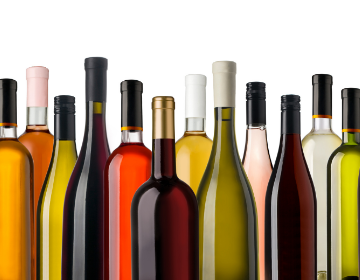 |
As vintage 2022 wraps up around Australia, thoughts will be turning to packaging for many wine producers. The AWRI helpdesk often sees the results when packaging goes wrong, whether it be insufficient heat or cold stabilisation, ineffective filtration, incorrect bottle pressures or simply not enough SO2. In fact, packaging and instability-related queries accounted for around 15% of total queries received last year and resulted in many complex investigations. To help producers avoid some of these common problems, the team developed a comprehensive set of resources on packaging. These cover steps from pre-packaging preparation right through to transport and storage. If you need help or have any packaging-related questions, contact the helpdesk on helpdesk@awri.com.au or 08 8313 6600. |
New fluorescence method for detecting haze-forming proteinshe methods currently used for testing heat stability of white wine can be time-consuming, expensive and may not always accurately predict the amount of bentonite required to achieve protein stability. This could lead to over-fining, which might strip out phenolics and aroma compounds, or under-fining, which could increase the risk of protein instability. As an alternative, an efficient and rapid fluorescence-based method to detect haze-forming proteins in white wines has been developed at the AWRI, with the work recently published in the journal Food Chemistry. The method uses a fluorescent compound that binds haze-forming proteins selectively. To validate it, a range of wines were analysed with results compared to an established HPLC method. A linear relationship was observed between the two methods over a range of relevant haze protein concentrations and the new method showed a low detection limit of 2 mg/L. The new technology can be deployed rapidly, without sample preparation, presenting an opportunity for routine testing. The full paper detailing this work is available from the AWRI library: Mierczynska-Vasilev, A., Vasilev, A., Reilly, T., Bindon, K., Vasilev, K. 2022. Fluorescence sensing technology for the rapid detection of haze-forming proteins in white wine. Food Chem. 374: 131770. For more information, contact Agnieszka Mierczynska-Vasilev on agnieszka.mierczynska-vasilev@awri.com.au. |
|
Sustainable Winegrowing Australia Impact Report – the results are in |
|
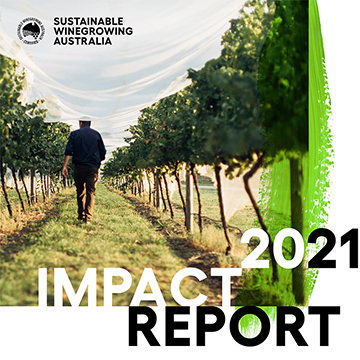 |
Sustainable Winegrowing Australia has released its inaugural Impact Report detailing the wide range of sustainable practices being successfully implemented by vineyards and wineries across Australia. The report outlines the program’s first national data set, covering the focus areas of Land and Soil, Water, Energy, People and Business, Biodiversity and Waste.
Some key highlights from the report include:
For more information on membership, visit https://sustainablewinegrowing.com.au/membership/ |
New partnership with international society |
|
 |
The AWRI recently joined The International Viticulture & Enology Society (IVES) as an academic member. IVES is an international academic association dedicated to viticulture and oenology. Founded in 2017 by a group of leading universities and research institutes, it aims to make the results of scientific research in this field freely available for researchers and professionals. IVES publishes OENO One, a vine and wine online open access peer-reviewed journal, IVES Technical Reviews – Vine and Wine, a tool to transfer current research to end users, and IVES Conference Series – Viticulture and Enology to collate proceedings from international conferences in viticulture and oenology (launched in 2021). |
Practices survey coming later this yearThe AWRI will be commencing the second edition of its comprehensive grape and wine practices survey in September. This follows the first survey conducted in 2016, which produced a detailed snapshot of vineyard and winery practices and equipment in use at that time. The goal of the survey, which will be repeated every six years, is to provide independent data tracking the evolution of vineyard and winery practices and technology adoption. If there are topics, practices or equipment that were not covered in the original survey that you think should be included in this second edition, we are interested to hear from you. Please email simon.nordestgaard@awri.com.au to suggest new additions to the survey. |
|
New irrigation videos |
|
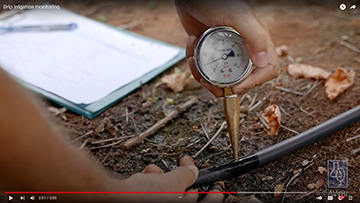 |
Two new videos – on irrigation monitoring and irrigation maintenance are now available now from the AWRI’s YouTube channel. These videos star irrigation expert Jeremy Giddings from Agriculture Victoria Services Pty Ltd presenting practical tips on getting the most out of a drip irrigation system. The videos form part of a Wine Australia-funded practice change project on irrigation, which also included workshops held earlier this month in inland regions. For more information on irrigation and water management, visit the AWRI’s water management page. |
AWITC – less than a month to go!It’s hard to believe that in four weeks’ time the 18th AWITC will be in full swing! Preparations are well underway across the AWRI, with staff contributing to the technical poster display, workshop program, plenary presentations and planning committee. Keep an eye on the AWITC website for all the latest news as our industry prepares to gather together in person and we look forward to seeing you at stand 1113 in the WineTech trade show. |
|
Season 2 of AWRI decanted podcast coming soon |
|
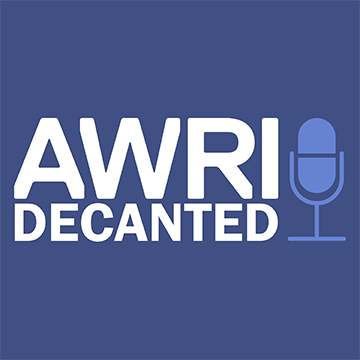 |
Keep an eye on your podcast app, as the second season of AWRI decanted is launching very soon! New episodes will be released fortnightly from mid-June, with episodes featuring viticulture research and practitioners who are putting it into practice. If you missed the first flavour-focused season, all episodes are still available – either search for AWRI decanted in your podcast app or listen directly from the podcast page on the AWRI website. |
Order the latest staff publications onlineAccessing the latest AWRI publications is easy. Visit the AWRI Publications web page to:
The AWRI’s most recent publications are listed below. 2281 Coulter, A. Ask the AWRI: Interpreting AWRI smoke panel analysis results. Aust. N.Z. Grapegrower Winemaker (698): 42-43; 2022 (link to article). 2282 Kassara, S., Norton, E., Mierczynska-Vasilev, A., Lavi Sacks, G., Bindon, K.A. Quantification of protein by acid hydrolysis reveals higher than expected concentrations in red wines: implications for wine tannin concentration and colloidal stability. Food Chem. 385: 132658; 2022 (link to article). 2283 Cordente, A.G., Curtin, C.D., Solomon, M., Kulcsar, A.C., Watson, F., Pisaniello, L., Schmidt, S.A., Espinase Nandorfy, D. Modulation of volatile thiol release during fermentation of red musts by wine yeast. Processes 10(3): 502; 2022 (link to article). 2284 González-García, L.E., MacGregor, M.N., Visalakshan, R.M., Lazarian, A., Cavallaro, A.A., Morsbach, S., Mierczynska-Vasilev, A., Mailänder, V., Landfester, K., Vasilev K. Nanoparticles surface chemistry influence on protein corona composition and inflammatory responses. Nanomaterials 12(4): 682; 2022 (link to article). 2285 Day, M., Wilkes, E., Kirby, J., Wright, C., Krstic, M. Analytical approaches to wine authenticity. Wine Vitic. J. 38(2): 29-31; 2022 (link to article). 2286 Dry, P. Grenache blanc. Wine Vitic. J. 38(2): p. 58 ; 2022 2287 Habili, N., Little, A., Essling, M., Rinaldo, A. Grapevine leafroll-associated virus 3 and its management strategies in vineyards. Wine Vitic. J. 38(2): 34-40 ; 2022 2288 Ntuli, R., Saltman, Y., Ponangi, R., Jeffery, D., Bindon, K., Wilkinson, K. Applications of flash détente for red wine style differentiation. Wine Vitic. J. 38(2): 20-24 ; 2022 2289 Pisaniello, L., Watson, F., Siebert, T., Francis, L., Hixson, J.L. The varietal influence of flavour precursors from grape marc on monoterpene and C13-Norisoprenoid profiles in wine as determined by Membrane-Assisted Solvent Extraction (MASE) GC-MS. Molecules. 27(7): 2046; 2022 (link to article). 2290 Capone, D.L., Francis, I.L., Clingleffer, P.R. Evidence that methoxypyrazine accumulation is elevated in Shiraz rachis grown on Ramsey rootstock, increasing ‘green’ flavour in wine. Aust. J. Grape Wine Res. 28(2): 304-315; 2022 (link to article). 2291 Essling, M., Schwarz, C. Ask the AWRI: How to get the most out of copper sprays. Aust. N.Z. Grapegrower Winemaker (699): 76-78; 2022. 2292 Onetto, C.A., Sosnowski, M.R., Van den Heuvel, S., Borneman, A.R. Population genomics of the grapevine pathogen Eutypa lata reveals evidence for population expansion and intraspecific differences in secondary metabolite gene clusters. PLoS Genetics 18(4): e1010153; 2022 (link to article). 2293 Wang, Y.M., Ostendorf, B., Gautam, D., Habili, N., Pagay, V. Plant viral disease detection: from molecular diagnosis to optical sensing technology-a multidisciplinary review. Remote Sens. 14(7): 1542; 2022 (link to article). |
|
AcknowledgementsThe AWRI acknowledges support from Australia’s grapegrowers and winemakers through their investment body, Wine Australia, with matching funds from the Australian Government. The AWRI is a member of the Wine Innovation Cluster in Adelaide, South Australia. |
|
Technical Review April 2022 issue available online
7 April 2022 >The April 2022 issue of Technical Review is now available online. Articles and abstracts can be viewed individually, or the full issue can be downloaded. The online format of Technical Review allows you to browse the list of the latest articles on grape and wine production by keyword, view article summaries, read full-text articles from open access journals and order journal articles (not available for open access) from the AWRI Library.
For copyright reasons, access to abstracts is available only to Australian winemakers and grapegrowers who pay the Wine Grapes or Grape Research levies. The technical notes authored by the AWRI are, however, freely available. If you have forgotten your password for the AWRI website, please use the forgotten password link to reset your password.
Below is a snapshot of what’s in this issue:
eNews – February 2022
25 February 2022 >Sustainable Winegrowing Australia certification for WIC Winemaking Services
Major grant for no- and low-alcohol production
Smoke background data published
Resources on scale and sooty mould
Latest information on sensors and automation
Sustainable Winegrowing Australia Impact report – coming soon
Order the latest staff publications online
Sustainable Winegrowing Australia certification for WIC Winemaking Services |
|
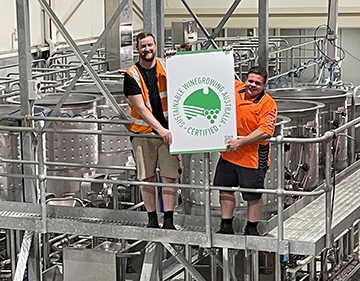 |
WIC Winemaking Services, the specialist contract winemaking service operated by the AWRI and the University of Adelaide, has just become a certified member of Sustainable Winegrowing Australia. This certification is testament to work conducted by Winemaker, John Gledhill and Assistant Winemaker, Russell Desmond, to collate all the required sustainability data, undergo training to prepare for certification, be audited and then perform any actions resulting from the audit. The team is proud to be able to demonstrate its sustainability credentials to all its clients. For more information on the services available from WIC Winemaking, contact john.gledhill@awri.com.au.
For other wineries or vineyards interested in certification, attendance at a certification training workshop is the first step. To receive notifications of all upcoming AWRI certification workshops, complete this EOI form. |
Major grant for no- and low-alcohol productionA $4.8 million grant was recently announced by the South Australian Government for the development of a world-leading no- and low-alcohol (NOLO) wine production capability. This funding will enable industry to undertake pilot-scale production of new NOLO products and better understand the market opportunities in this growing consumer segment. The program funded by the grant will be delivered by the AWRI, the University of Adelaide, Wine Australia and Australian Grape & Wine and is structured as four pillars: Pillar 1 – Establishment of a pilot/trial-scale production facility The AWRI will be directly involved in Pillar 1 (led by WIC Winemaking Services) and Pillar 2 (led by Dr Wes Pearson, Dr Simon Nordestgaard and Dr Josh Hixson). For more information, contact enquiries@awri.com.au. |
|
Smoke background data published |
|
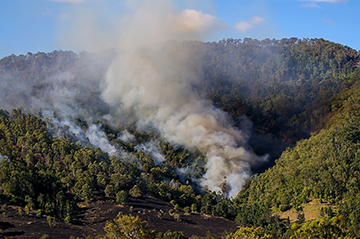 |
When grapes are analysed to assess the risk of smoke exposure, the marker compounds used are a selection of volatile phenols and their glycosides. However, these compounds are also present naturally at trace levels in non-smoke-exposed grapes, which can complicate the interpretation of smoke analysis results. To address this, the AWRI collected data on the trace levels of smoke marker compounds in non-smoke exposed grapes of 12 varieties across Australia over four vintages. The grapes were fermented to wine and the concentrations of marker compounds in the wines were also added to the database. Analytical results for grapes or wine can be compared to the background levels database to determine the likelihood of smoke exposure. This work has recently been published as an open access article in the Australian Journal of Grape and Wine Research. The AWRI is working on expanding the background levels database to 16 varieties and data for additional varieties will be collected this vintage. |
Vintage trials underwayAs vintage 2022 kicks off around Australia, AWRI researchers are also busy setting up this year’s crop of vintage trials, which form an important part of many research projects. Some of the goals of this year’s trials include:
The AWRI thanks all the industry collaborators involved in these and other trials and looks forward to sharing the results. For more information on any of these trials, please contact enquiries@awri.com.au. |
|
Resources on scale and sooty mould |
|
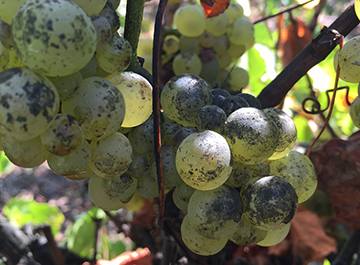 |
A number of regions across Australia have recently reported issues with scale insects on vines and associated sooty mould on grape bunches. Scale insects are common in Australian vineyards but typically do not cause enough damage to warrant action to control them. In some circumstances, however, the population can reach a threshold where intervention is required to avoid fruit being downgraded or rejected. The AWRI’s page on scale insects and sooty mould provides a range of useful resources, including fact sheets, articles and a webinar detailing a red wine trial conducted in 2017 with sooty-mould-affected grapes. For more information or assistance, contact the AWRI helpdesk on helpdesk@awri.com.au or 08 83136600. |
Latest information on sensors and automationAWRI Senior Engineer, Simon Nordestgaard, has been keeping his finger on the pulse of developments in tank instrumentation and has conducted trials of some of the latest sensors that can help to automate manual processes. He published updates on this work in two recent articles in the Australian & New Zealand Grapegrower and Winemaker, with the first focusing on automated ways to measure ferment density and liquid volume, and the second covering new options for measuring H2S in ferments. This vintage, Simon will be extending this work, focusing on density measurements in red ferments and yeas cultures. |
|
Sustainable Winegrowing Australia Impact report – coming soonSustainable Winegrowing Australia will soon release its first ‘Impact Report’ – summarising data collected by the program to demonstrate how Australian grapegrowers and winemakers are working to continuously improve their sustainability practices. The report will include data for vineyard and winery members across six key focus areas: Land and Soil, Water, Energy, People and Business, Biodiversity and Waste. Members of the program will be emailed a copy of the report first and it will then be made available from http://sustainablewinegrowing.com.au by mid-March. |
|
Order the latest staff publications onlineAccessing the latest AWRI publications is easy. Visit the AWRI Publications web page to:
The AWRI’s most recent publications are listed below. 2263 Mierczynska-Vasilev, A., Vasilev, A., Reilly, T., Bindon, K., Vasilev, K. Fluorescence sensing technology for the rapid detection of haze-forming proteins in white wine. Food Chem. 374: 131770; 2022. 2264 Cruz, F.C.S., Habili, N., Wu, Q., Sagarino, R.B., Randles, J.W. Detection of ‘Candidatus Phytoplasma luffae’ in sponge gourd, bitter gourd, and bamboo from Laguna in Luzon, Philippines. Philipp. Agric. Sci. 104(2): 181-185; 2021. 2265 Barter, S., Siebert, T., Bramley, R., Herderich, M., Krstic, M. Better late than never: the formation of distinctive pepper aromas in cool-climate Shiraz. Wine Vitic. J. 37(1): 35-37; 2022. 2266 Dry, P. Inzolia. Wine Vitic. J. 37(1): p. 68; 2022. 2267 Krstic, M. The Australian Wine Research Institute: Annual Report 2021. Aust. N.Z. Grapegrower Winemaker (695): 88-91; 2021. 2268 Krstic, M.P., Culbert, J.A., Parker, M., Herderich, M.J. Smoke taint and climate change. Reynolds, A.G. (ed.) Managing wine quality. Volume 1: Viticulture and wine quality. 2nd Edition: Cambridge, MA ; Oxford, UK : Woodhead Publishing. (Chapter 17.4): 763-778; 2021. 2269 Nordestgaard, S. Beyond Baumé rounds and tank dips. Aust. N.Z. Grapegrower Winemaker (695): 76-81; 2021. 2270 Schmidt, S., Holdstock, M. Ask the AWRI: Aerating red ferments. Aust. N.Z. Grapegrower Winemaker (695): 53-54; 2021. 2271 Wilkinson, K.L., Ristic, R., McNamara, I., Loveys, B., Jiang, W., Krstic, M. Evaluating the potential for smoke from stubble burning to taint grapes and wine. Molecules 26(24): 7540; 2021. 2272 Espinase Nandorfy, D., Siebert, T., Watson, F., Keast, R., Francis, I.L. Understanding the interactive effects of volatile compounds contributing to ‘stone fruit’ aroma nuances in white wines. Aust. J. Grape Wine Res. doi: 10.1111/ajgw.12540 : 1-15; 2021. 2273 Onetto, C.A., Costello, P.J., Kolouchova, R., Jordans, C., McCarthy, J. Schmidt, S.A. Analysis of transcriptomic response to SO2 by Oenococcus oeni growing in continuous culture. Microbiol. Spectr. 9(2): e01154-21; 2021. 2274 Sawyer, S., Longo, R., Solomon, M., Nicolotti, N., Westmore, H., Merry, A., Gnoinski, G., Ylia, A., Dambergs, R., Kerslake, F. Autolysis and the duration of ageing on lees independently influence the aroma and composition of traditional method sparkling wine. Aust. J. Grape Wine Res. 28(1): 146-159; 2022. 2275 Villarreal, P., Villarroel, C., O’Donnell, S., Agier N., Quintero-Galvis, J., Peña, T., Nespolo, R., Fischer, G., Varela, C., Cubillos, F. Late Pleistocene-dated divergence between South Hemisphere populations of the non-conventional yeast L. cidri. Authorea. DOI: 10.22541/au.164182824.45750907 /v1: 2022. 2276 Cordingley, B. Ask the AWRI: Sacrificial yeast cultures for SO2 reduction. Aust. N.Z. Grapegrower Winemaker (696): 52-53; 2022. 2277 Keast, R., Liem, G., Francis, L., Nandorfy, D. Food files: unravelling the flavour of white wine. Food Aust. 74(1): 30-31; 2022. 2278 Dixon, R. Ask the AWRI: How to tame an unruly canopy. Aust. N.Z. Grapegrower Winemaker (697): 54-57; 2022. 2279 Coulter, A., Baldock, G., Parker, M., Hayasaka, Y., Francis, I.L., Herderich, M. Concentration of smoke marker compounds in non-smoke-exposed grapes and wine in Australia. Aust. J. Grape Wine Res. doi: 10.1111/ajgw.12543 : 1-16; 2022. 2280 Nordestgaard, S. Measuring stinky ferments in situ. Aust. N.Z. Grapegrower Winemaker (697): 62, 64-68, 70-71; 2022. |
|
AcknowledgementsThe AWRI acknowledges support from Australia’s grapegrowers and winemakers through their investment body, Wine Australia, with matching funds from the Australian Government. The AWRI is a member of the Wine Innovation Cluster in Adelaide, South Australia. |
|
Technical Review February 2022 issue available online
17 February 2022 >The February 2022 issue of Technical Review is now available online. Articles and abstracts can be viewed individually, or the full issue can be downloaded. The online format of Technical Review allows you to browse the list of the latest articles on grape and wine production by keyword, view article summaries, read full-text articles from open access journals and order journal articles (not available for open access) from the AWRI Library.
For copyright reasons, access to abstracts is available only to Australian winemakers and grapegrowers who pay the Wine Grapes or Grape Research levies. The technical notes authored by the AWRI are, however, freely available. If you have forgotten your password for the AWRI website, please use the forgotten password link to reset your password.
Below is a snapshot of what's in this issue:
Top tasting skills rewarded
7 February 2022 >7 February 2022
The Australian Wine Research Institute (AWRI) announced today that Ben Cane was the dux of the 52nd Advanced Wine Assessment Course.

